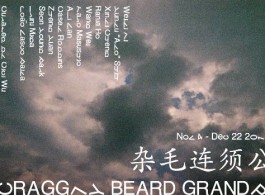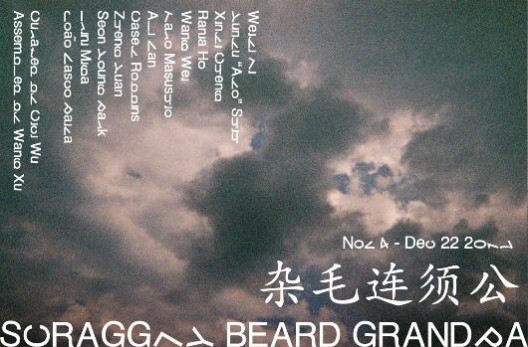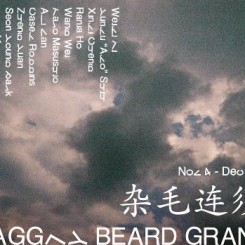Capsule Shanghai
This letter is penned after PRACTICE has been around for two years, during which we had experienced fifteen projects and exhibitions with artists from very different backgrounds. PRACTICE was founded in New York by three artists born in China, serving as our studio (and also a free space for artists excepting the founders to work and sleep), exhibition space, hotpot restaurant, and mahjong house. The artists with whom we have collaborated were born in Korea, Japan, Greece, the United States of America, Croatia, Portugal, Taiwan, and some who were born in one place, but grew up on the other side of the Atlantic Ocean. But this phenomenon is nothing rare in a place like New York; in fact, it is very common. I’m writing this letter today to update some thoughts, but not necessarily from a bird’s eye view (we often find ourselves trying to unify many minute and fine things). I would like to start from a very intimate and real place—changing language barrier and friendship between artist peers.
When Zhang Huan arrived in New York in 1998, who was his best friend? Who was Cai Guo-Qiang’s non-Chinese best friend in New York? What was the conversation between them about? Does the meaning of life reside in studying other cultures and reflecting on one’s own? Why do people care or not care about these issues? Here at PRACTICE, we shared much happiness. It comes partly from artists’ desire to create, partly from the necessity and pleasure for communication. This kind of communication didn’t revolve around eating, drinking, or gossip, but rather questions generated out of states of urgency, regarding society, geography, economics, life, physics, and art. In the process of conversing with Irini Miga, Taro Masushio, Seon Young Park, Ali Van, João Vasco Paiva, Casey Robbins, Yunyu “Ayo” Shih, Wang Wei, and Rania Ho, PRACTICE continually found new inspirations. These artists are like mirrors, in the sense that they allow us to see that we could have more than one pair of eyes (imagine what it’s like when many pairs of eyes flutter open on the same body). It is true that English isn’t our mother tongue. We all started from mimicking. Without even knowing whether if it is absolutely necessary (there wasn’t enough time to make a decision), but we all naturally became bi-lingual, tri-lingual (during the period of Korea under Japanese rule, refugees escaped to Manchuria and study Chinese, which was the only mandatory language used for communication. Their mother tongue was forbidden into whispers: only at night could they be enunciated as lightly as possible, for the sole purpose of not forgetting)[2].
We never had the opportunity to think over or decide whether we needed these languages, but before we could respond, we had already learnt them. It’s luck that we have encountered friends from different countries and backgrounds, our bi-lingual or tri-lingual (computing language) tongues not only served as the basis for communication, but also opened up new modes of thinking (logic). Language, evolving from a tool to a habit, became a game.
We spent many nights at PRACTICE just talking. These conversations were not all profound, sometimes we fought for trivial things. The word “emotional” is especially suited for PRACTICE, perhaps because the three founders all came from a place that acts on emotional impulses. People are always held together by a thin membrane led by emotions (mianzi, guanxi, yiqi, family). As such, many artists witnessed the so-called “Chinese way” of fighting, but they also experienced the “Chinese way” of sharing (selflessly helping others), trust, modesty (the ability to withstand adversity), as well as a forgiveness that seemed to run in our blood. I always thought this was the most unique character that made PRACTICE stand out as an artists run space in New York (that is, asides from its deliberate purposelessness). On another level, artists like Xinyi Cheng, Weiyi Li, and Zheng Yuan were all born in China and came to study in the US. We met in the US, and started to question our identity and the culture of the homeland. We all thought of emailing each other to keep in contact—we didn’t have long to stay together. Everyone live in different places—they each have their own mission. But those momentary connections forged in the past are profound, enough to slightly shape each other’s work and life.
Asides from Warhol (1928-1987) and Beuys (1921-1986), we should also remember Robert Filliou (1926-1987). He came up with the “Genial Republic”, which aimed to be an ideal society beyond national affiliation and underscored the independence of the inquisitive. Each person is their own territory.
I was on the phone with a friend at noon today. “What do you think of when you make work?”, I ask. He answered: “I would think…am I adding a new piece of garbage to this world?” (Another voice from 1991 starts ringing in my ear: “Do you believe that you have made an impact on the Western art world?”)[3]
Culture is a kind of fruit, the result of production and consumption, shaped according to people’s needs and beliefs. Yet these needs and beliefs should be explained by historical, technological, geographical, and economic determinants. What is the culture of our homeland? Whether we left because we have no choice, or we linger at the confusion of having too many choices, at the end of the day, I know that I have some little friends by my side. Through time and space, our friendship gradually changes our identity.[4]
__________________
[1] Pseudonym of Fei Dawei, used in a letter to Li Xianting in 1991.
[2] Excerpt from Dictee, an auto-ethnographic novel about the self and nation-states by Korean-American artist Theresa Hak Kyung Cha, 1982.
[3] A question that Li Xianting asked in his letter to Fei Dawei in 1991.
[4] Press release of Mathew Berliner Mauer, Amy Lien and Enzo Camacho, 2014.



